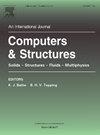Vershinin–Bai–Wierzbicki plastic model for mild steel and accurate prediction of structural plastic response and failure behavior
IF 4.8
2区 工程技术
Q1 COMPUTER SCIENCE, INTERDISCIPLINARY APPLICATIONS
引用次数: 0
Abstract
The isotropic plastic hardening behavior of ductile metals is commonly characterized by the accumulated equivalent plastic strain. Advanced plasticity models further incorporate dependencies on hydrostatic pressure and Lode angle to more accurately represent material behavior under complex stress states. However, such models have rarely been applied to mild steels or structural failure analyses. This study evaluates the applicability of the Vershinin–Bai–Wierzbicki (VBW) model to mild steel, such as Q235 in China. Constitutive parameters are calibrated using a parameter identification approach that integrates inverse modeling with multi-objective optimization. Computational results of the VBW and Mises models are compared, with particular attention to differences in the large-deformation plastic stage. In addition, the VBW model incorporating the Lode angle-modified void growth model (LMVGM) is evaluated for its capability to predict fracture behavior and structural failure responses. Simulation results indicate that plastic deformation and fracture behavior of mild steel under large strains are highly sensitive to stress triaxiality and Lode angle. The conventional Mises model fails to accurately capture plastic evolution influenced by these stress-state parameters, whereas the VBW model, coupled with LMVGM, provides accurate predictions of both large-strain plasticity and fracture responses in mild steel materials and structures.
低碳钢的Vershinin-Bai-Wierzbicki塑性模型及结构塑性响应和破坏行为的精确预测
塑性金属的各向同性塑性硬化行为通常以累积等效塑性应变为特征。先进的塑性模型进一步纳入了对静水压力和Lode角的依赖,以更准确地代表材料在复杂应力状态下的行为。然而,这种模型很少应用于低碳钢或结构失效分析。本研究评估了Vershinin-Bai-Wierzbicki (VBW)模型对中国Q235等低碳钢的适用性。本构参数的校准使用参数识别方法,集成了反演建模和多目标优化。比较了VBW模型和Mises模型的计算结果,特别注意了大变形塑性阶段的差异。此外,结合Lode角修正空隙生长模型(LMVGM)的VBW模型对其预测断裂行为和结构破坏响应的能力进行了评估。模拟结果表明,大应变下低碳钢的塑性变形和断裂行为对应力三轴性和Lode角高度敏感。传统的Mises模型无法准确捕捉受这些应力状态参数影响的塑性演化,而VBW模型与LMVGM相结合,可以准确预测低碳钢材料和结构的大应变塑性和断裂响应。
本文章由计算机程序翻译,如有差异,请以英文原文为准。
求助全文
约1分钟内获得全文
求助全文
来源期刊

Computers & Structures
工程技术-工程:土木
CiteScore
8.80
自引率
6.40%
发文量
122
审稿时长
33 days
期刊介绍:
Computers & Structures publishes advances in the development and use of computational methods for the solution of problems in engineering and the sciences. The range of appropriate contributions is wide, and includes papers on establishing appropriate mathematical models and their numerical solution in all areas of mechanics. The journal also includes articles that present a substantial review of a field in the topics of the journal.
 求助内容:
求助内容: 应助结果提醒方式:
应助结果提醒方式:


